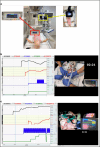Impact of the Neonatal Resuscitation Video Review program for neonatal staff: a qualitative analysis
- PMID: 39367199
- PMCID: PMC12279539
- DOI: 10.1038/s41390-024-03602-9
Impact of the Neonatal Resuscitation Video Review program for neonatal staff: a qualitative analysis
Abstract
Background: Neonatal resuscitation video review (NRVR) involves recording and reviewing resuscitations for education and quality assurance. Though NRVR has been shown to improve teamwork and skill retention, it is not widely used. We evaluated clinicians' experiences of NRVR to understand how NRVR impacts learning and can be improved.
Methods: Neonatal Intensive Care Unit (NICU) clinicians with previous NRVR experience were recruited for individual semi-structured interviews. Using a social constructivist viewpoint, five researchers used thematic analysis to analyze participant responses.
Results: Twenty-two clinicians (11 nurses, 11 doctors) were interviewed. All participants expressed positive attitudes towards NRVR. Four themes were identified: (1) Learning from reality-exposure to real-life resuscitations was highly clinically relevant. (2) Immersive self-regulation-watching videos aided recall and reflection. (3) Complexities in learner psychological safety-all participants acknowledged viewing NRVR videos could be confronting. Some expressed fear of judgment from colleagues, though the educational benefit of NRVR superseded this. (4) Accessing and learning from diverse vantage points-NRVR promoted group discussion, which prompted participant learning from colleagues' viewpoints.
Conclusion: Neonatal clinicians reported NRVR to be an effective and safe method for learning and refining skills required during neonatal resuscitation, such as situational awareness and communication.
Impact: Neonatal resuscitation video review is not known to be widely used in neonatal resuscitation teaching, and published research in this area is limited. Our study examined clinician attitudes towards an established neonatal resuscitation video review program. We found strong support for teaching using neonatal resuscitation video review among neonatal doctors and nurses, with key benefits including increased situational awareness and increased clinical exposure to resuscitations, while maintaining psychological safety for participants. The results of this study add evidence to support the addition of video review to neonatal resuscitation training.
© 2024. The Author(s).
Conflict of interest statement
Competing interests: D.A.B. reports financial support was provided by the Australian National Health and Medical Research Council. All other authors declare no competing interests. Ethical approval: Neonatal resuscitation videos were acquired with a waiver of parental consent and verbal assent from the attending neonatal staff members under an ongoing quality improvement project approved by the Monash Health Human Research Ethics Committee. A second ethics application was approved by MH-HREC to obtain informed, written consent to conduct semi-structured interviews with clinicians who had attended scheduled NRVR sessions. Informed consent: Written informed consent was required for all participants in this study.
Figures



Similar articles
-
Health professionals' experience of teamwork education in acute hospital settings: a systematic review of qualitative literature.JBI Database System Rev Implement Rep. 2016 Apr;14(4):96-137. doi: 10.11124/JBISRIR-2016-1843. JBI Database System Rev Implement Rep. 2016. PMID: 27532314
-
The effectiveness of using non-traditional teaching methods to prepare student health care professionals for the delivery of mental state examination: a systematic review.JBI Database System Rev Implement Rep. 2015 Aug 14;13(7):177-212. doi: 10.11124/jbisrir-2015-2263. JBI Database System Rev Implement Rep. 2015. PMID: 26455855
-
Neonatal Nurses' Understanding of the Factors That Enhance and Hinder Early Communication Between Preterm Infants and Their Parents: A Narrative Inquiry Study.Int J Lang Commun Disord. 2025 Jul-Aug;60(4):e70093. doi: 10.1111/1460-6984.70093. Int J Lang Commun Disord. 2025. PMID: 40653954 Free PMC article.
-
[Volume and health outcomes: evidence from systematic reviews and from evaluation of Italian hospital data].Epidemiol Prev. 2013 Mar-Jun;37(2-3 Suppl 2):1-100. Epidemiol Prev. 2013. PMID: 23851286 Italian.
-
A New Measure of Quantified Social Health Is Associated With Levels of Discomfort, Capability, and Mental and General Health Among Patients Seeking Musculoskeletal Specialty Care.Clin Orthop Relat Res. 2025 Apr 1;483(4):647-663. doi: 10.1097/CORR.0000000000003394. Epub 2025 Feb 5. Clin Orthop Relat Res. 2025. PMID: 39915110
References
-
- Madar, J. et al. European Resuscitation Council Guidelines 2021: newborn resuscitation and support of transition of infants at birth. Resuscitation161, 291–326 (2021). - PubMed
-
- Yamada, N. K., Yaeger, K. A. & Halamek, L. P. Analysis and classification of errors made by teams during neonatal resuscitation. Resuscitation96, 109–113 (2015). - PubMed
-
- Williams, A. L., Lasky, R. E., Dannemiller, J. L., Andrei, A. M. & Thomas, E. J. Teamwork behaviours and errors during neonatal resuscitation. Qual. Saf. Health Care19, 60–64 (2010). - PubMed
MeSH terms
LinkOut - more resources
Full Text Sources

